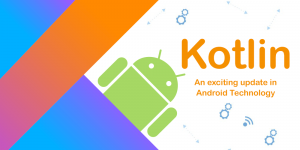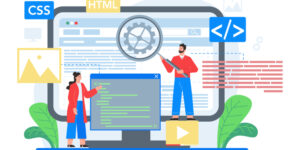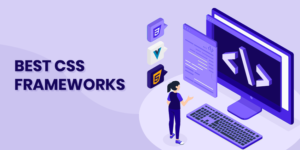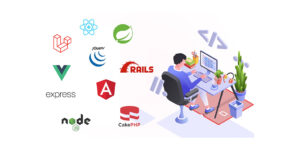
Java, one of the world’s most popular programming languages, has a vast and thriving ecosystem of frameworks for web development. These frameworks provide a solid foundation for developers to create powerful and reliable web programs. The options are vast and varied, from traditional MVC frameworks to modern microframeworks.
This article will look at the best Java frameworks for web development, each with unique features and advantages. If you are a professional programmer or beginning, this list offers something. So, let’s dive in!
What is the java framework?
A Java framework is a set of pre-written, pre-tested, and pre-documented libraries and classes that provide a standard structure for developing a particular type of application, such as web or desktop applications. The main advantage of using a framework is that it saves time and effort by providing a standardized solution to common programming problems, letting programmers concentrate on writing their application’s particular parts.
Frameworks promote good coding practices, making developing maintainable and scalable applications easier. Java has a rich ecosystem of frameworks, each offering different features and approaches to development, and the choice of framework depends on the project’s specific requirements.
Java frontend framework
Java is not typically used as a front-end programming language but as a server-side language for building backend systems. However, Java can build frontend components, such as applets, for use within a web page.
HTML, CSS, and JavaScript are the most commonly used technologies for building a web application’s user interface (UI). Several popular frontend frameworks make it easier to create UI elements, such as:
- Angular: A comprehensive framework for building single-page applications.
- Vue.js: A progressive JavaScript framework for designing user interfaces.
- Ember.js: A framework for building enterprising web apps.
- Backbone.js: A lightweight framework for producing web apps.
- Svelte: A new-generation JavaScript framework for building fast and reactive user interfaces.
- Mithril.js: A small and fast JavaScript library for building web applications.
These frontend frameworks can be used with a Java backend to create a complete web application.
Type of framework in Java
There are several types of frameworks in Java; some popular ones are:
- Web Application Frameworks: such as Spring, JavaServer Faces (JSF), Struts, etc.
- Enterprise Application Frameworks: such as Java Enterprise Edition (Java EE), Spring, etc.
- Mobile Application Frameworks: such as Android, PhoneGap, etc.
- Testing Frameworks: such as JUnit, TestNG, etc.
- Logging Frameworks: like Log4j, Java Util Logging, etc.
- Security Frameworks: Apache Shiro, Spring Security, Java Authentication and Authorization Service (JAAS), etc.
These are some commonly used Java web frameworks, but many more are specific to a particular use case or requirement.
Java framework Spring
Spring is a widely used, open-source Java framework for building Java applications, particularly enterprise-level applications. It provides a comprehensive set of features and tools for building and maintaining applications, including:
- Inversion of Control (IoC) and Dependency Injection (DI) for managing the relationships between elements in an app.
- A rich set of modules for building web applications, such as Spring MVC, Spring WebFlux, and Spring WebSockets.
- Support for data access and persistence, including ORM (Object-Relational Mapping), JDBC (Java Database Connectivity), and NoSQL databases.
- A comprehensive security framework, including authentication and authorization, encryption, and more.
- Instruments for creating and installing cloud-based applications, including support for cloud-native development with Spring Cloud.
- An extensive set of libraries and APIs for handling everyday tasks and scenarios, such as email, messaging, and more.
Spring’s modular architecture and wide range of features make it a popular choice for developing various applications, from simple web applications to complex, enterprise-level applications.
What is the framework in Java with an example?
A framework in Java is a bunch of pre-written, reusable elements and libraries that deliver a system for creating software application programs. The purpose of a framework is to simplify development by providing a standardized way of building, deploying, and maintaining applications.
For example, consider the Spring framework. Spring provides a comprehensive set of components for building Java applications, including modules for building web applications, data access, security, and more. Java developers can use these components as a starting point rather than writing the code from scratch.
This preserves time and exertion and helps out assure that the code is high quality and follows best practices. With Spring, developers can focus on writing the unique and specific parts of the application while relying on the framework to handle everyday tasks and provide a consistent structure for the application. This can make the outcome more rapid and well-organized, resulting in more accessible applications to sustain and upgrade over time.
10 Best Java Frameworks For Web Development
1. Spring
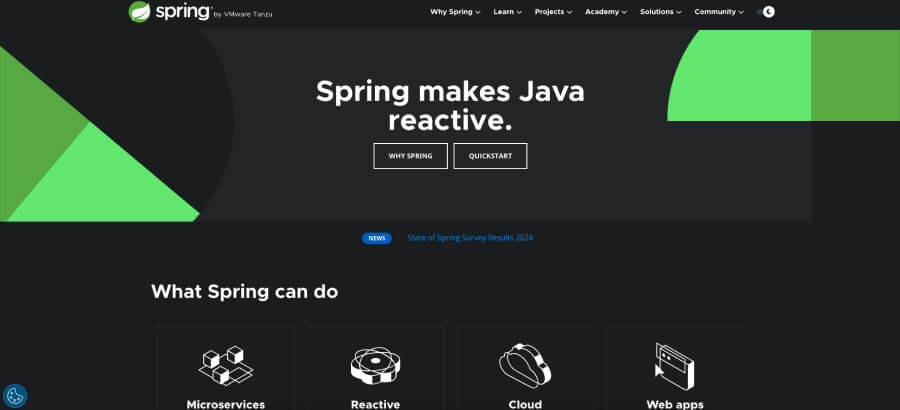
Spring Framework refers to an arrangement of libraries aiding Java app development, particularly for intricate enterprise-level applications. Dependency injection (DI), object lifecycle management, security, and database access are among the things supported by these libraries. Essentially, it can be thought of as a “container” for creating powerful and reusable Java components.
- Open-source application framework for creating Java-based business apps.
- Furnishes a complete programming and composition standard for contemporary Java-based apps.
- Offers modular, flexible, and easily testable code, allowing for rapid development and maintenance of applications.
- Inversion of Control (IoC) and Dependency Injection (DI) promotes loose coupling between elements and enable easier testability.
- Supports a wide range of data access technologies, including JDBC, Hibernate, and JPA, for connecting to databases and performing data access operations.
- Includes a comprehensive web framework for building web applications, with support for REST, MVC, and WebSockets.
- Integrates with other popular frameworks and libraries, including Hibernate, Struts, and JSF, for building complete, full-stack applications.
- Provides a robust security framework supporting authentication, authorization, and encryption.
- Includes powerful tools for testing and debugging, such as JUnit, TestNG, and Spring Boot Actuator.
- It offers a flexible configuration model, allowing developers to choose the best configuration approach for their specific needs.
- Has a big and enthusiastic community of customers and programmers, with extensive online documentation and help. It is widely used as a Java framework for the backend.
2. Hibernate
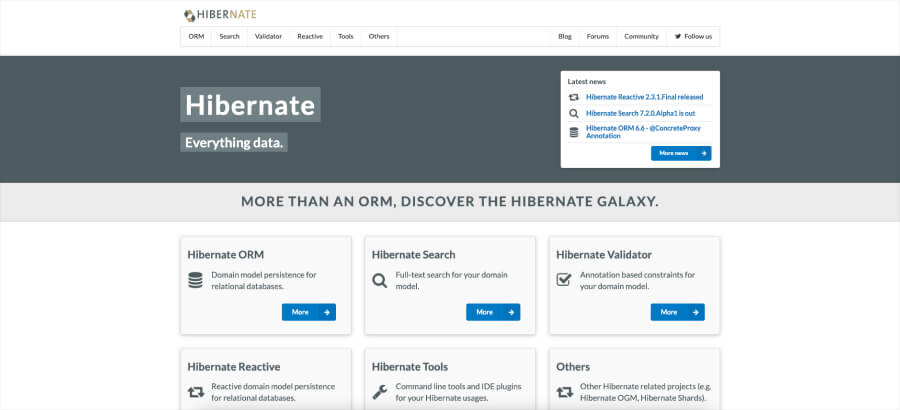
Hibernate is a Java object-relational mapper (ORM) framework, which acts like a translator making it easier for your Java objects to interact with a relational database. Instead of writing complicated SQL, Hibernate allows you to carryout database operations using Java object and also ensures persistence.
- Open-source Object-Relational Mapping (ORM) framework for Java-based applications.
- Provides a high-level, easy-to-use API for performing database operations, reducing the need for manual, low-level JDBC code.
- Backs many relational databases, including MySQL, Oracle, and Microsoft SQL Server.
- Features a powerful query language, Hibernate Query Language (HQL), for performing complex database operations.
- It offers a flexible caching system, allowing for improved performance and scalability.
- Provides transaction management and multi-threading support, promoting efficient, safe, and scalable database operations.
- Includes powerful tools for testing and debugging, such as JUnit and TestNG.
- Integrates well with other popular frameworks and libraries, including Spring Framework and Java Persistence API (JPA).
- It offers a flexible configuration model, allowing developers to choose the best configuration approach for their specific needs. One of the best Java frameworks for web development is widely used as a Java framework for the backend.
3. Apache Struts
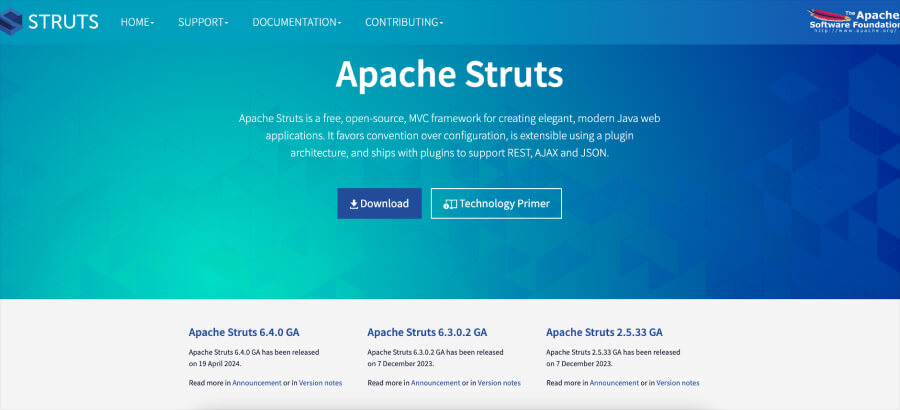
Apache Struts is a web application framework for Java built with a free, open-source Model-View-Controller (MVC) architecture. It allows clean code separation and maintainability by design. Developers can avoid writing repetitive code through Struts which includes the following features:
- Open-source Model-View-Controller (MVC) framework for creating Java-based web apps.
- Provides a flexible, modular architecture for developing complex web applications, promoting code reusability and maintainability.
- Features a powerful, extensible tag library for building dynamic, data-driven user interfaces.
- Includes support for internationalization (I18N), allowing applications to be effortlessly localized for various languages and areas.
- Offers a robust security framework supporting authentication, authorization, and encryption.
- Integrates well with other famous Java web application frameworks and libraries, like Spring Framework and Hibernate.
- It provides a flexible configuration model, allowing developers to choose the best configuration approach for their specific needs.
- Has a big and energetic circle of customers and developers, with extensive online documentation and service.
- Aids a broad spectrum of web technologies, including JavaServer Pages (JSP), JavaServer Faces (JSF), and Ajax
4. JavaServer Faces
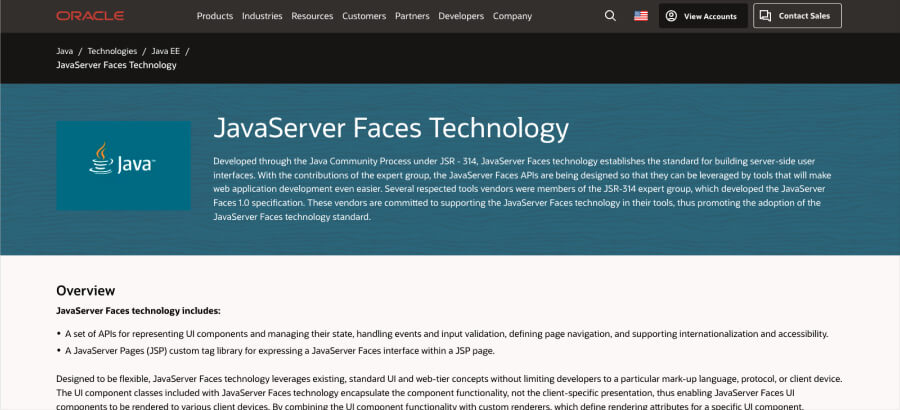
JavaServer Faces (JSF) is a Java web framework for creating custom interfaces for web applications. A component-based framework provides a standard way to develop and render user interfaces. Mentioned below are the unique qualities of JSF:
- Component-Based Architecture: JSF provides a rich set of pre-built UI components, such as input fields, buttons, and tables, that can be used to build complex user interfaces.
- Customizable Components: JSF provides the ability to customize pre-built components or create new features that meet specific application requirements.
- Event-Driven Model: JSF provides an event-driven model that allows developers to handle user interactions and navigate between pages in the application.
- Bean Management: JSF provides built-in support for managing application state through managed beans.
- Navigation Handling: JSF provides a standard way to handle navigation between pages in the application, making it easier to build complex navigation flows.
- Validation Framework: JSF provides a validation framework that allows developers to validate user input before processing it.
- Internationalization Support: JSF provides built-in support for internationalization, allowing applications to be localized for different languages and regions.
- AJAX Support: JSF provides built-in support for AJAX, making building dynamic, responsive user interfaces more accessible.
- Integration with Other Java Technologies: JSF integrates well with other Java technologies, such as Java Persistence API (JPA) and Enterprise JavaBeans (EJB), making it easier to build full-stack Java applications. It’s one of the best Java frameworks for web development.
5. Play
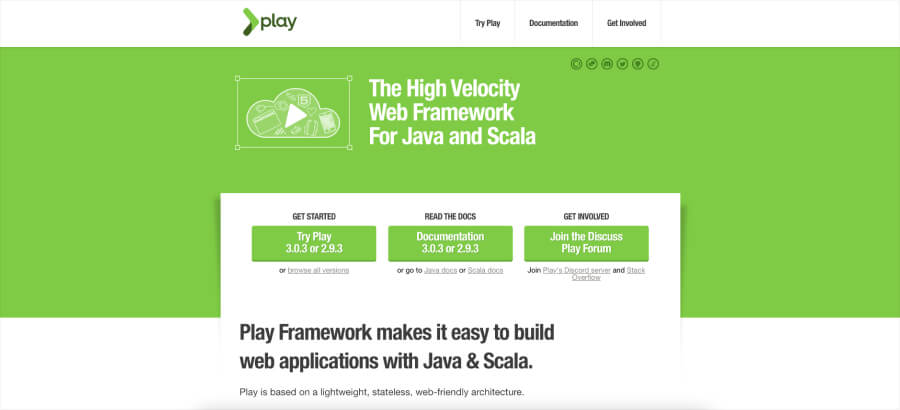
The Play Framework is a high-performance, lightweight framework for building scalable, fast, and maintainable web applications in Java and Scala. The following are the unique features of Play Framework:
- Modular Design: Play Framework follows a modular design, allowing developers to choose only the components they need, reducing the overall size of the application.
- Stateless Architecture: Play Framework follows a stateless architecture, making it easy to scale applications horizontally and reduce the complexity of managing sessions.
- Reactive Programming Model: Play Framework provides a reactive programming model that makes it easier to build asynchronous, non-blocking applications that can handle large numbers of concurrent users.
- Built-in Support for HTTP/2: Play Framework provides built-in support for HTTP/2, allowing applications to take advantage of the latest performance optimizations in web protocols.
- Hot Reloading: Play Framework provides hot reloading, allowing creators to modify their code and see the outcomes instantly, not needing a complete reconstruction.
- Built-in Testing Support: Play Framework provides built-in support for testing, making it easier to write and run automated tests for the application.
- Integration with Other Technologies: Play Framework integrates well with other technologies, such as Apache Cassandra and Apache Solr, making it easier to build full-stack applications.
- Built-in Security Features: Play Framework provides built-in security features, such as encryption and protection against common web attacks, to help keep applications secure.
- Open Source: Play Framework is open source and actively developed, with a large and active community of contributors and users. It can also be a good option as a java framework for the backend.
6. Grails
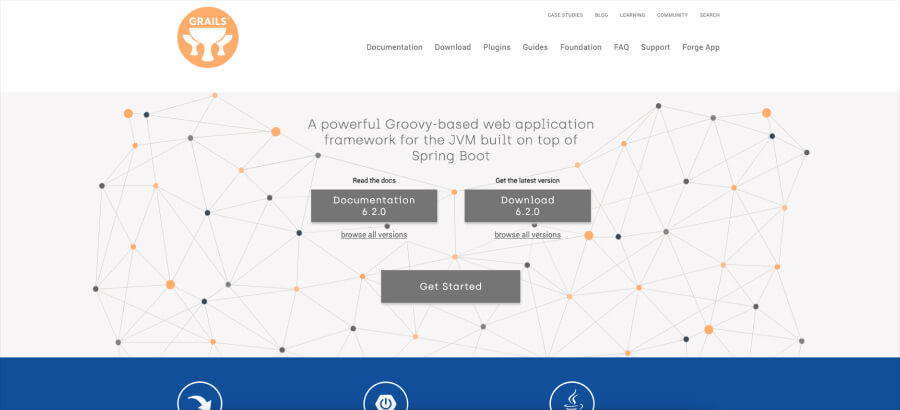
Grails is a high-productivity web application framework for building scalable, fast, and maintainable applications in Groovy, a dynamic language for the Java platform. The following are the unique features of Grails:
- Convention-over-Configuration: Grails follows a convention-over-configuration approach, reducing the boilerplate code needed to start a new project.
- Dynamic Language: Grails is built on top of Groovy, a dynamic language for the Java platform that provides a high level of expressiveness and readability.
- Object Relational Mapping: Grails provides built-in support for Object Relational Mapping (ORM), making it easy to interact with databases and perform CRUD operations.
- Plugins: Grails has a rich ecosystem of plugins, permitting developers to add the latest elements and components to their apps quickly.
- Testing Support: Grails provides built-in support for testing, making it easier to write and run automated tests for the application.
- Rapid Development: Grails provides a high level of productivity, allowing developers to build and deploy applications quickly.
- Built-in Security Features: Grails provides built-in security features, such as encryption and protection against common web attacks, to help keep applications secure.
- Integration with Other Java Technologies: Grails integrates well with other Java technologies, such as Java Persistence API (JPA) and Enterprise JavaBeans (EJB), making it easier to build full-stack Java applications and one of the best Java web frameworks.
- Open Source: Grails is open source and actively developed, with a large and active community of contributors and users. One of the finest Java web application frameworks.
7. Vaadin
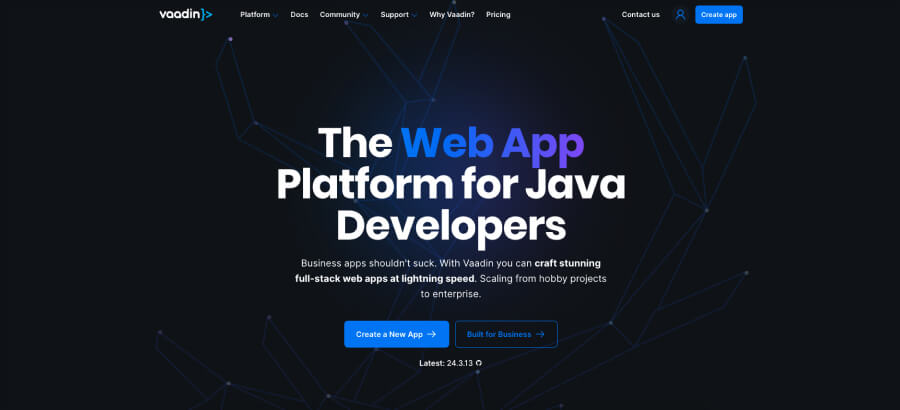
Vaadin is a Java web application framework for building business-oriented, single-page web applications. The following are the unique features of Vaadin:
- UI Components: Vaadin provides a rich set of UI components, making it easy to build modern, responsive web applications.
- Server-Driven Architecture: Vaadin follows a server-driven architecture, allowing for fast and responsive applications, even with complex and large datasets.
- Built-in Data Binding: Vaadin provides built-in data binding, making it easy to bind data from a database or other sources to UI components.
- Modular Design: Vaadin follows a modular design, allowing developers to choose only the components they need, reducing the overall size of the application.
- Customizable Themes: Vaadin provides customizable themes, allowing creators to instantly adjust the look of their app to match their brand.
- Testing Support: Vaadin provides built-in support for testing, making it easier to write and run automated tests for the application.
- Integration with Other Java Technologies: Vaadin integrates well with other Java technologies, such as Java Persistence API (JPA) and Enterprise JavaBeans (EJB), making it easier to build full-stack Java applications.
- Open Source: Vaadin is open source and actively developed, with a large and active community of contributors and users.
- Community Edition and Pro Edition: Vaadin offers both a Community Edition, with essential features and support, and a Pro Edition, with additional features and support options.
8. Apache Wicket
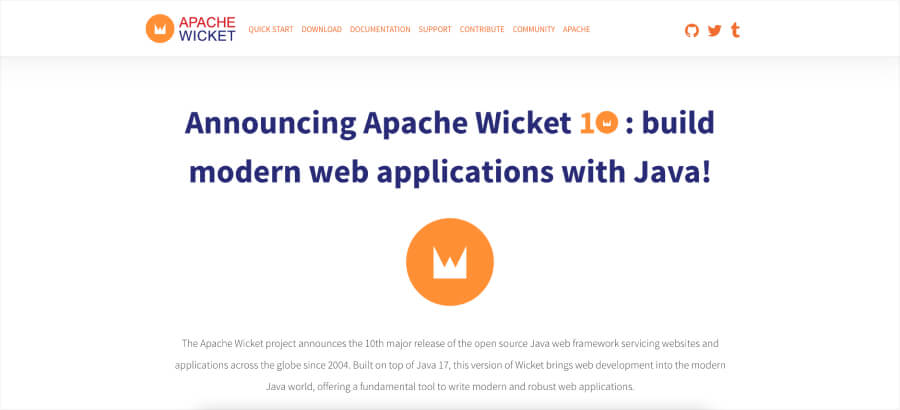
Apache Wicket is a component-based Java web application framework for building scalable, fast, and maintainable applications. The following are the unique features of Apache Wicket:
- Component-Based Architecture: Apache Wicket follows a component-based architecture, making it easy to reuse UI components and simplify the development of large web applications.
- Pure Java: Apache Wicket is written in pure Java, making it easy to integrate with other Java technologies and utilize existing Java libraries.
- Built-in AJAX Support: Apache Wicket provides built-in support for AJAX, allowing developers to quickly create dynamic and interactive web applications.
- Stateful Pages: Apache Wicket provides stateful pages, making it easy to maintain the state of a page across multiple requests, even if the user navigates away from the page and returns later.
- Testing Support: Apache Wicket provides built-in support for testing, making it easier to write and run automated tests for the application.
- Customizable Themes: Apache Wicket provides customizable themes, permitting developers to instantly modify the look of their app to match their brand.
- Open Source: Apache Wicket is open source and actively developed, with a large and active community of contributors and users.
- Good Documentation: Apache Wicket provides good documentation, including a comprehensive user guide and API documentation, making it easier for developers to get started with the framework. One of the best collection frameworks in Java.
9. JHipster
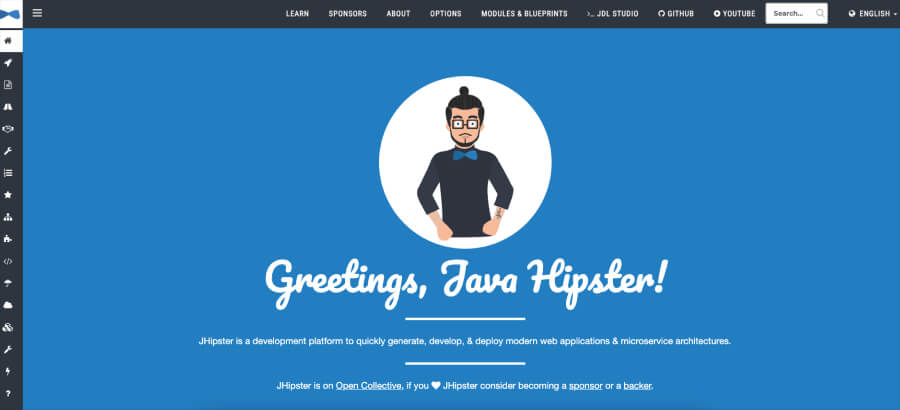
JHipster is a generator for creating modern web applications using popular technologies such as Angular or React for the front end and Java for the back end. The following are the unique features of JHipster:
- Rapid Application Development: JHipster provides a high level of productivity, allowing developers to quickly generate a working application skeleton and start building their applications.
- Modern Stack: JHipster uses a current stack, including Angular or React for the front end and Spring Boot for the back end, making it easy to create scalable and maintainable applications.
- Microservices Architecture: JHipster supports creating microservices architecture, allowing developers to build scalable and highly-available applications.
- Built-in Security Features: JHipster provides built-in security features, such as encryption and protection against common web attacks, to help keep applications secure.
- No XML Configuration: JHipster follows a convention-over-configuration approach and does not use XML configuration files, reducing the amount of boilerplate code needed to get started with a new project.
- Docker and Kubernetes Support: JHipster provides built-in support for Docker and Kubernetes, making it easy to deploy applications in a cloud-native environment.
- Multiple Databases Support: JHipster supports various databases, including SQL and NoSQL, making it easy to choose the proper database for the application.
- Open Source: JHipster is open source and actively developed, with a large and active community of contributors and users and the best collection framework in Java
10. Blade
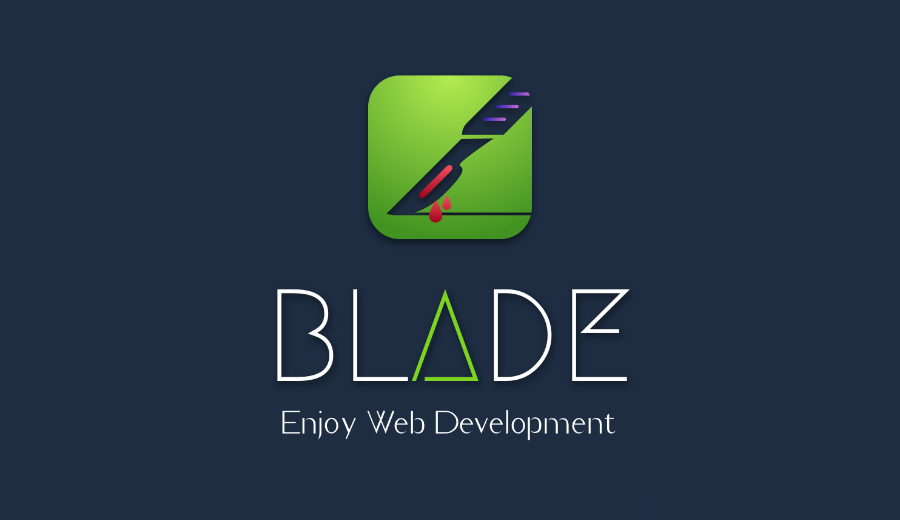
The blade is a Java-based micro-service framework that provides fast and efficient development of high-performance web applications. The following are the unique features of Blade:
- Micro-service Architecture: Blade follows a micro-service architecture, allowing developers to build scalable and highly-available applications.
- Fast and Lightweight: Blade is designed to be quick and lightweight, making it ideal for building high-performance web applications.
- Easy to Use: Blade provides a simple and intuitive API, making it easy for developers to start with the framework.
- Modular Design: Blade follows a modular design, allowing developers to choose only the components they need, reducing the overall size of the application.
- Built-in Security Features: Blade provides built-in security features, such as encryption and protection against common web attacks, to help keep applications secure.
- Support for Multiple Databases: Blade supports multiple databases, including SQL and NoSQL databases, making it easy to choose the proper database for the application.
- Open Source: Blade is open source and actively developed, with a large and active community of contributors and users.
Conclusion
many Java frameworks are available for web development, each with unique features and strengths. The top 10 Java frameworks for web development include Spring, JavaServer Faces (JSF), Play Framework, Grails, Vaadin, Apache Wicket, JHipster, Blade, Struts, etc. Some of the key features these frameworks offer include component-based architecture, support for microservices, built-in security features, and support for multiple databases.
When choosing a Java framework for web development, it is essential to consider the project’s specific requirements and the development team’s skills. Some frameworks may be better suited for small projects, while others may be better for large and complex projects. Eventually, the proper framework will rely on the project’s exact requirements and the development team’s preferences. We hope this blog on the best Java frameworks for web development is useful to the readers.

